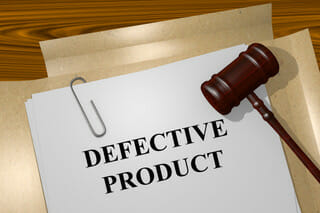There are many dangerous and defective products that cause serious injury. Many times the manufacturer or the seller of a defective product can be held liable for manufacturing or selling the product if it is “defective” and causes injury under the products liability theory of strict liability.
Defective Products

- Defective automobile parts, such as defective airbags, seatbelts or tires
- Children’s Toys and Products – Children are often not able to understand dangers of a product that should not be marketing to children.
- Medical Devices and pharmaceuticals – Medical devices sometimes are designed or manufactured with defects because they were not properly tested. Also, medications can be defective if they have not been tested for certain risks are or badly labeled.
- Household Appliances – Sometimes small electrical devices or appliances can cause electrocution or fire even if being used properly.
In a products liability case based on the theory of strict liability, the injured consumer must prove that the product or component of a product was in a defective condition as sold.
A consumer’s safety cannot be guaranteed as there are always risks involved in using a product. There is a question as to how much consumer risk is acceptable when using a product versus the manufacturer’s liability to an injured consumer, even when the consumer has accepted the risk.
The Pennsylvania Supreme Court held in Tincher v. Omega Flex, Inc., 104 A.3d 328 (Pa. 2014), that there are 2 ways to show a product is in a defective condition: (1) the danger is unknowable and unacceptable to the average or ordinary consumer (Consumer Expectations Test), or that (2) a reasonable person would conclude that the probability and seriousness of harm caused by the product outweigh the burden or costs of taking precautions (Risk-Utility Test).
The Consumer Expectation Test

The test asks the question whether a consumer would reasonably anticipate and appreciate the product’s danger and its potential to cause injury. In other words, would this “surprise” an ordinary consumer that the product could cause this type of injury? This works for simple products that a customer may have an expectation about.
For example, if someone buys a car, they are generally not expecting it to explode. If the car was designed to have an open and exposed gas tank with an open flame next to it, a reasonable person would determine that it is faulty by design. This would be considered a design defect by the consumer expectations test. However, not all products are as simple as that, nor is it apparent how a reasonable person would perceive certain aspects of a product. Given the same example of the car, if the gas tank is not open and exposed but rather placed in a different part of the car, a reasonable person might not know the level of risk associated with the placement of the gas tank in an automobile.
What is a Risk-Utility Test?
The risk-utility test is essentially a cost-benefit analysis by assessing a product’s risk compared to its utility. The plaintiff must prove that the risk of using a product is outweighed by its utility. Under this standard, a product is defective if a “reasonable person” would determine that the probability and seriousness of harm that the product will cause actually outweighs the burden or costs of taking precautions.
This risk utility balance test was adopted by the Restatement (Third) of Torts: Products Liability, which acknowledges that the main idea of risk utility balancing is to determine whether or not a product is defective.
When is the manufacturer liable?
The test implies that the manufacturer will be held liable if the probability of harm and the seriousness of the injury by its design is more than the cost of changing the design to something that is reasonably safer and the diminished utility of the alternative design. So while the risk utility test is theoretically intended to compare the product’s risk against its utility, in actuality it compares a product’s risk with the economic costs of an alternative design.
Courts have decided that in some cases one test works better than the other. The consumer expectation test is not the only way to determine whether or not a product is defective. For products that are complex enough, the risk-utility test is often used. However, under the Pennsylvania Supreme Court’s decision in Tinder v. Omega Flex, Inc.,, the court held a plaintiff may use a “composite,” or a combination of the two tests to meet his burden. The combined standard states the consumer expectations and risk-utility tests in the alternative, offering the parties a composite of the most practical elements of both tests.






